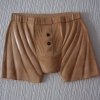Finishing off the Romanesque acanthus. There is no undercutting; this style of leave is quite 'chunky', heavy and undercutting always make leaves look lighter.

| 19 September 2017 11:10
Denny - The #9 gouge is a semicircle, a #10 becomes more U-shaped and thus isn't an arc of a circle any more, and a #11 gouge is properly U-shaped. It doesn't matter which one of these deep gouges you use on either side of the pipe to make the channel, the wood between which you round over to form your pipe.
The #10 gouge I am using in the video was made by Henry Taylor. It's U-shaped with the walls being slightly opened so they are not parallel.

| 18 September 2017 20:14
Hi there Chris. I started this project was happily on my way surprising myself at how well I was doing. When it came to carving the pipes, I kind of got stumped. Your video as well as the PDF instructions call for using a #10/10 and #10/6. I thought I had one, but could not find it my tool roll. I looked at Woodcraft and several other suppliers, even asked the expert Google, and they do not list a #10, it goes from #9 to #11. The Sheffield list shows a #10. I am sure you were using a #10, but who was the manufacturer???
I used one of my #11's, so no problem in finishing the project, but curious about the #10.
Thanks...
Denny

| 24 June 2014 16:20
Steve - I'm using what's called the 'paper-sandwich' method of holding work. Look here: Videos > Techniques > Holding Work > Delicate Carvings.

| 23 June 2014 16:37
Was the leaf simply glued top the clamping plank with wood glue?

| 22 October 2013 13:47
Thanks Chris a true masters.